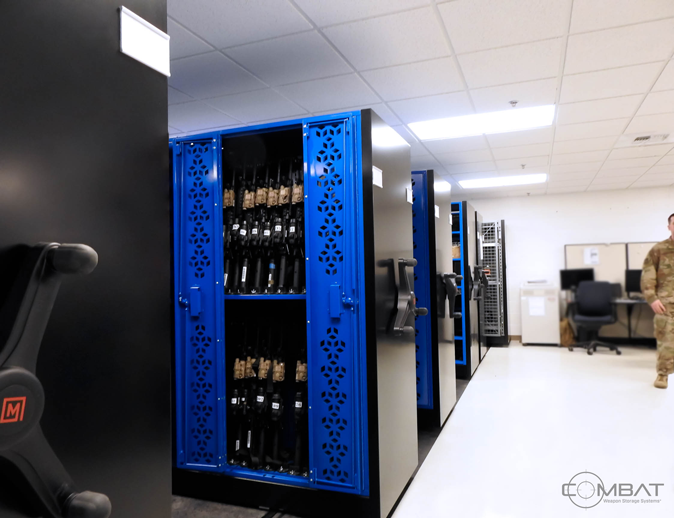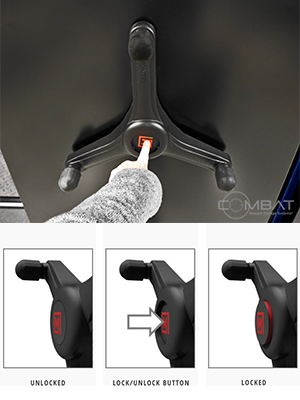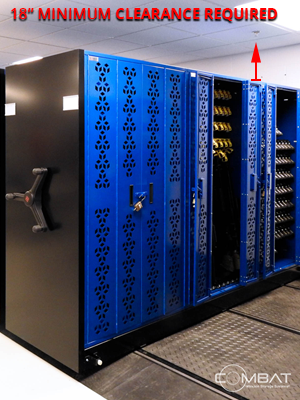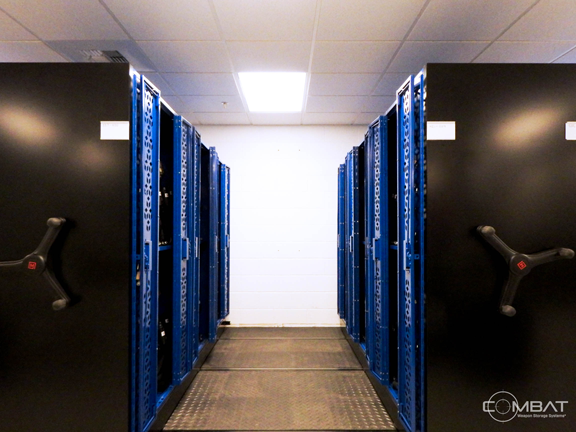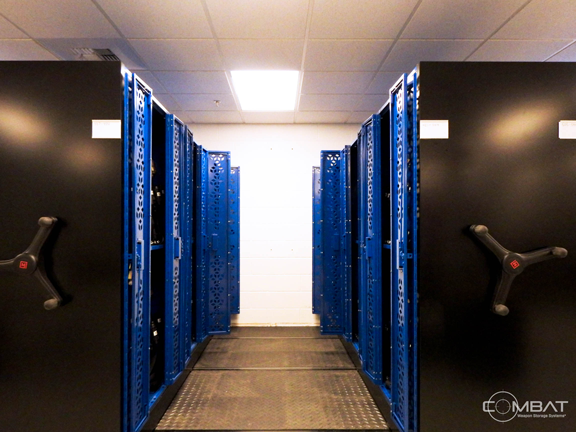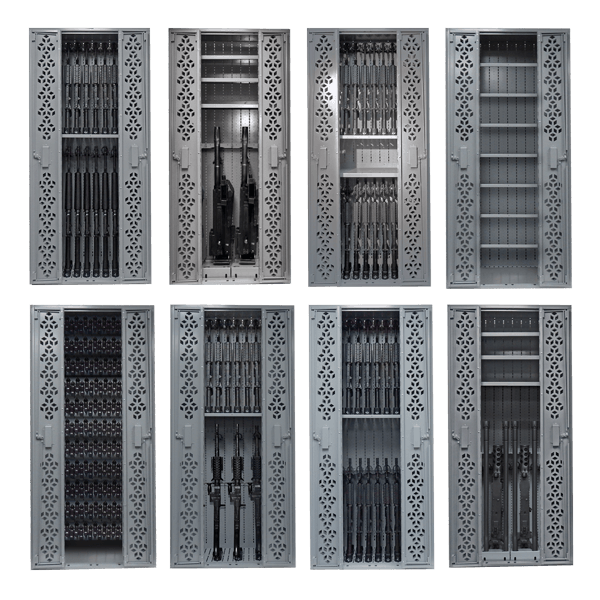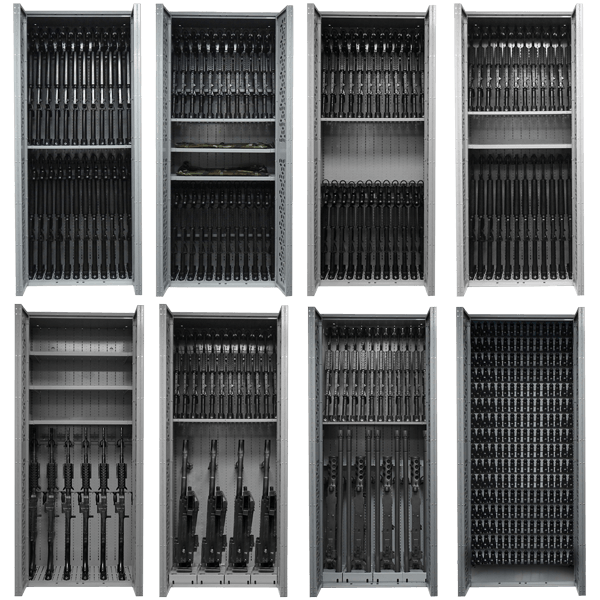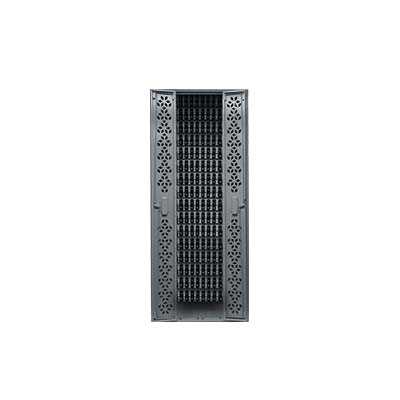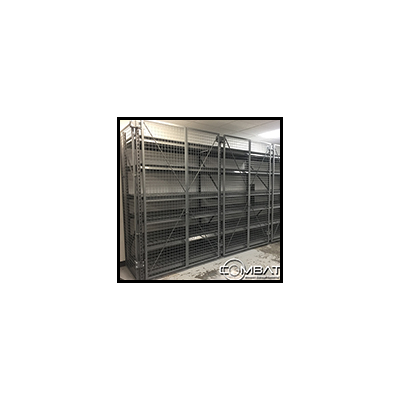How to Build an Armory
- Determine the amount of space available inside the arms room with an Armory Site Survey.
- Review the weapon density list against Weapon Rack Storage Capacity.
- How many weapon racks do I need?
- Contact us for GSA weapon rack pricing or review NSN Weapon Racks for supply system purchases.
High Density Weapon Storage Systems conceptually are designed to eliminate fixed aisles between static rows of weapon racks or shelving and increase storage capacity by doing so. This entails installing track across the width of the armory space being utilized for storage, placing rolling, movable carriages on top of the track and then mounting weapon racks and shelving on top of those carriages. The carriages can then be moved from side to side with a 3 spoke ergonomic handle for aisle access.
Things to consider for high density weapon storage system implementation.
- Workflow in the Armory
- Installation of the System
- Anti-Tip Track
- Floor Covering
- Safety Features
- 18″ Fire Sprinkler Clearance
- Reverse Bi-Fold Doors
Armory Workflow
Designing a high density weapon storage system starts with a site survey. Surveying your arms room, we are able to measure the space to get the H x W x D of the entire space and also to review any obstructions that need to be worked around (IDS, pipes, vents, power outlets, HVAC, fire alarms, fire sprinklers, etc).
Once the usable space is obtained, the room can be drawn in AutoCAD. After reviewing the MTOE or weapon density list, we are then able to determine exactly how many weapon racks are needed to store the weapons and gear. The system designer is then able to apply the number of weapon racks to the armory space using the necessary weapon rack heights and widths.
In active armories, high density weapon storage systems need to account for how many armorers may need access to the system at the same time. With every armory typically being a unique space, this means that some armories will need multiple access aisles for armorers to work within the system. Longer carriages will allow for more access and storage capacity for weapons in one aisle than shorter carriages do.
Installation of High Density Weapon Storage Systems
The single most important part of a mobile storage system is the track and the installation of the track. If the track is installed out of level or ever becomes out of level, the carriages will have performance issues that will cause failure over time.
The track should be installed level, to the high spot of your concrete slab, anchored and fully grouted continuously under the entire span of each piece of track. Grout packed under the track keeps the track from ever coming out of level. Systems using only leveling feet should be avoided as leveling feet can shift and become out of level easily, causing major system issues.
Anti-Tip Track
The system should also be sold with anti-tip track. Anti-tip track protects the system from any seismic events or from a carriage from ever flipping over. Anti-tip track has a channel along the entire length of the track with a gripper plate installed under the carriage riding in the channel.
Unlevel tracks causes the anti-tip bracket to hit the track in high &/or low spots causing friction or resistance that eventually wears down carriage gears and chains. We replaced a system with an out of level track recently that caused major performance issues for the armory, because it was not grouted.
Floor Covering
Once the track is leveled, anchored and fully grouted, wood decking is installed between the rails and finished with floor covering, typically rubber matting to protect the floor and weapons if they are dropped.
The track and flooring is then completed with a non-skid ADA compliant steel ramp.
Tracks can also be installed embedded in concrete. The option to embed track in concrete is typical in new construction and eliminates having to install decking, flooring between tracks and an entry ramp.
Mobile Storage System Safety Features
Mobile Storage systems are available with standard carriage or aisle locks that are active locks, typically a knob or button that locks the handles in front of an aisle that protects the end user from the carriages closing on them when they are inside of the system.
In an armory, these safety mechanisms are likely not going to get used with armorers carrying weapons in and out of weapon racks. An additional safety mechanism that is highly effective for high density weapon storage systems is the mechanical safety brake. This is a gravity fed mechanical safety brake along the bottom of the weapon racks at toe level in the carriage. Users need only apply pressure to the bar to cease closure should the carriages begin to collapse on an active aisle while they are still inside.
The mechanical safety brake is best used in active arms rooms with more than one access aisle and also for longer carriages. If an armorer forgets to press the push button on the handles to lock the carriages, the toe level bar (when pressed) automatically stops the carriage.
18″ Fire Sprinkler Clearance
Meeting fire and building codes is important to make sure your armory isn’t written up.
Fire code requires storage to be 18″ under sprinklers. When placing weapon racks on top of mobile carriages, we are adding 7″ of overall height to the weapon racks with the height of the track and 5″ wheels of carriages. This means we need to start with the floor to sprinkler height and deduct the growth of the carriages and the 18″ fire sprinkler clearance to know what height weapon rack we can use in your space.
Reverse Bi-Fold Doors
Rolling carriages to open aisles is accomplished with the simple turn of a 3 spoke ergonomic rotating handle. This handle has a chain that is connected to a full length drive shaft, ensuring that all wheels are turning at the same time. Multiple carriages can be moved using one handle as carriages include bumpers between carriages.
There are several different styles of weapon rack doors. For a high density mobile storage system, you will want a system that does not require closing every weapon rack door to move carriages.
Reverse Bi-Fold doors fold in half, flush to the front of weapon racks with the ability to flex out. Carriages can be moved without having to close every weapon rack door fully.
Bi-Fold Weapon Rack doors plague arms rooms as armorers are forced to constantly open and close doors when moving carriages, reducing workflow and increasing the time it takes to issue weapons.
Retractable Door Weapon Racks require more physical floor space and store less weapons per rack. This lost space will require a larger armory footprint to store weapons and gear compared to Reverse Bi-Fold Doors.
Fully Hinged Weapon Rack Doors open up into aisles and must be constantly opened and closed to move carriages and work around while in aisles.
76″ H Combat Weapon Racks allow for some weapons to be stored double tiered depending on the height of each weapon.
- Double Tier carbines with room for storage shelves
- One tier of full height rifles (M16s/Shotguns) & one tier of carbines
85″ H Combat Weapon Racks allow for double tiering of rifles as well as mixing and matching of many different weapon systems and configurations.
- Double tier M16s & Shotguns
- Double tier M4s with M9s and multiple storage shelves
- Store M240s with M4s or shelves above
- Store M2/MK19s with M4s or shelves above
Turnkey High Density Weapon Storage systems are offered via our GSA Schedule, GS-07F-0661W or via DLA’s Tailored Logistics Support (TLS) programs.


